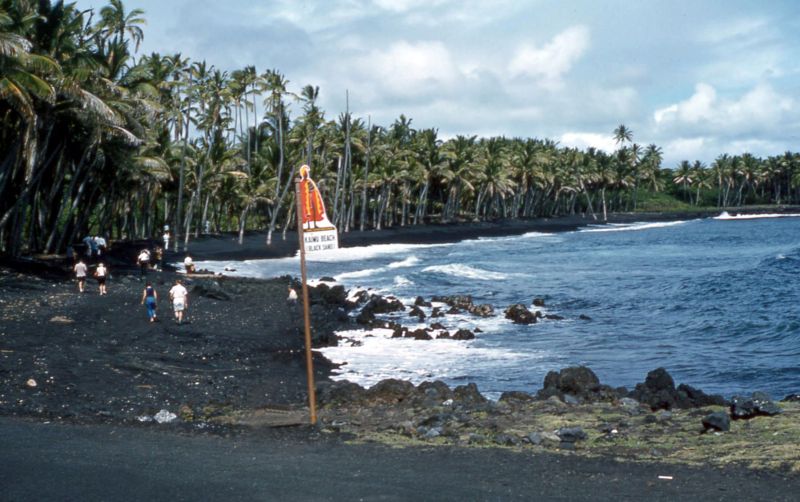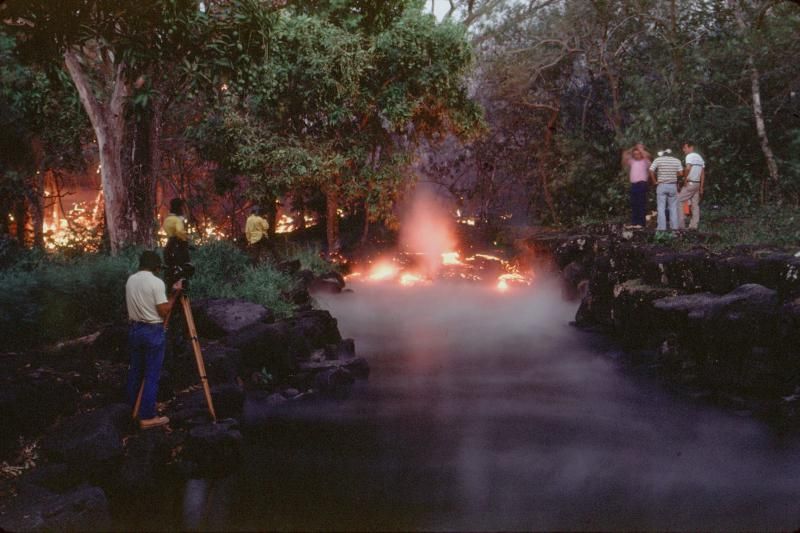Digital Collections
Celebrating the breadth and depth of Hawaiian knowledge. Amplifying Pacific voices of resiliency and hope. Recording the wisdom of past and present to help shape our future.
Kīhei de Silva
Haku mele: Uncertain. It has been attributed to Harry Nā‘ope and Harry Keli‘iho‘omalu.
Sources: 1) Tony Conjugacion and Kawai Cockett, who learned it from Vickie Ii Rodrigues. 2) G.Girl Keli‘iho‘omalu, who credits the song to Harry Keli‘iho‘omalu, her husband’s uncle.
Discography: 1) Tony Conjugacion, Pure Tony, Kahanu KMI 14001. 2) Kawai Cockett, ‘O Ka‘ōhao Ku‘u ‘Āina Nani, Ho‘olokahi HPC 203. 3) G.Girl Keli‘iho‘omalu, Kalapana i ka Wā Kahiko, Kaimū Records, GG0001.
Text below: As learned by Kawai Cockett from Vickie Ii Rodrigues. Translation: Kīhei de Silva. Variations in the Keli‘iho‘omalu text are enclosed in brackets.
Mokuhulu i ka malu o ka ‘ulu [niu]
Ia home uluwehi
Pua kani lehua [Pua ka lehua]
Kaimū i ke ‘ala līpoa
I ka hone a ke kai [Ia home o ke kai]
I ka pu‘e one.
Kalapana, ka niu moe o Queen ‘Ema
Ia wahi kaulana
No ka malihini.
Kapa‘ahu ia puna lu‘u
Ia wai hu‘ihu‘i
Hu‘i koni i ka ‘ili.
Ha‘ina ‘ia mai ka puana
No Puna ke ‘ala
I lawe ‘ia mai nei.
Mokuhulu in the ‘ulu shade
This verdant home
Of rain-rustled lehua blossoms.
Kaimū in the fragrance of līpoa
In the sweet song of the sea
On the hilled-up sand.
Kalapana, the niu bent low for Queen Emma
This place well-known
To visitors.
Kalapana, this pool for swimming
This tingling-cold water
So thrilling to the touch.
Sing the summary
From Puna comes the fragrance
That has carried here to me.
Although it was probably composed in the early 20th century, "Mokuhulu" belongs to a style of late 19th century Hawaiian poetry called hula ku‘i; the style is defined by structure that is strophic (composed in verses), verses that are short (usually two lines each), line cadences that are regular, "tunes" that are interchangeable, themes that involve aloha ‘āina and the exaltation of chiefs, and literal meanings that often read like simple travelogues (Amy Stillman, "History Reinterpreted in Song," Hawaiian Journal of History, 1989:19–24). Katherine Luomala and Samuel Elbert contend, furthermore, that the hula ku‘i’s artless structure, predilection for place-names, image-rich but transition-deficient language, and love of familiar expressions strike the western ear as unsophisticated at best and "a heap of foolishness" at worst (Luomala, "Creative Processes in Hawaiian Use of Place Names in Chants," Laographia, 22:234–237). To the tradition-steeped Hawaiian ear, however, the simplicity of a hula ku‘i like "Mokuhulu" is a well-crafted deception: the song’s names, descriptions, and echoes are designed to trigger powerful mental pictures of beloved people, locations, and events and to lavish upon them "a golden aura of affection":
Speakers of Hawaiian never tire of hearing [these names and descriptions] over and over, and on hearing them one recalls his own grandmother or older relative who used to say them, and one has heard some of them in songs. They thus reinforce ties to family as well as to places . . . ties with the land and the sea, the source of life . . . and are a link with a past that in many ways seems still a glorious never-never land. [Elbert, "Connotative Values of Hawaiian Place Names, Directions in Traditional Pacific Literature, 121–122.]
"Mokuhulu" was composed in celebration of a people’s ties to the seven mile stretch of Puna coastline bordered on the east by Mokuhulu and on the west by Kapa‘ahu. The song summons four wahi pana (storied places) to the mind's eye by providing brief but image-rich sketches of each. In verse one, Mokuhulu is called forth in the quick, deft strokes of sheltering ‘ulu and rain-rustled ‘ōhi‘a lehua. The two images open gateways of memory for natives of Puna: Mokuhulu was once home to a famed ‘ulu grove that bore fruit for eight months of the year; it was home, as well, to an ‘ōhi‘a lehua grove whose rain-pattered blossoms created a music that perhaps rivaled Hilo’s own "ua kani lehua."
In verse two, Kaimū is re-created from the smells and sounds of a līpoa fragrant sea washing over dunes of black sand. The description triggers a wealth of associations that includes surfing, royalty, hospitality, and a chant legacy commemorating all three. The opening verses of Lunalilo’s mele inoa "Aihea ‘o Kalani," for example, celebrate his riding on the lala and muku waves of Hō‘eu (one of three Kaimū breaks; the others are Kalehua—for children—and ‘Āwili—for the gods), his coming ashore at Kaimū where people had gathered to watch, and his bathing at a nearby fresh-water pool (MS SC Roberts 4.2:68a–70).
In verse three, the same tradition of hospitality to visiting ali‘i is evoked in the allusion to a Kalapana coconut tree pulled low for Queen Emma in 1883: "mounted on a horse, [Emma] held a single coconut leaf . . . while the people pulled and strained until the tree was bent. Then the tree was fastened down so that it would grow in a reclining position (Pukui, ‘Ōlelo No‘eau, #2280). Pukui reminds us that this custom was unique to Kalapana, that Emma and Ululani were the last of many ali‘i to be so honored, and that niu moe were often mentioned in chants and songs of Puna.
In verse four, Kapa‘ahu is brought to life with a plunge into the chilly pool of Punalu‘u (more recently known as Queen’s Bath). The spring, which issued from seemingly solid rock to fill a long, deep cavity in the pāhoehoe, stirs memories of the shark man who lived there, the agricultural heiau that stood on its banks, and—by extension—the much loved series of springs that dotted the Kalapana coast. Reference to the skin-tingling water of Punalu‘u calls to mind the similar effects of Lonowai at Kaimū, and of Wai‘ākōlea and Waiko‘olihilihi at Kalapana; it calls to mind, as well, a deep love for all that nurtures the land, sustains its people, and refreshes its guests.
In verse five, the song’s function as a container of memory, or more specifically as a vessel of memory-triggers, culminates in the metaphor of fragrance. Each of Kalapana’s districts contributes to the perfume of "Mokuhulu." That ‘ala carries to us from Puna, and it sets off a chain of cherished mental pictures whose effect is mesmerizing: when we inhale it, we are there. The language of this verse, as with much of the language in the preceding verses, is not new. The almost identical "No Puna ke ‘ala i hali ‘ia mai" can be found in the well-known "Hi‘ilawe" and the lesser known "Mauna Kea." In a song meant to stir fond memories, familiarity of this sort breeds the opposite of contempt; it compounds the resonance and depth of words that bind us, in love, to Puna.
Of the four districts named in "Mokuhulu" only Mokuhulu itself is unfamiliar to the malihini. Although Tony Conjugacion’s liner notes for Pure Tony refer to it as the Blackman Estate, G.Girl Keliʻihoʻomalu identifies Mokuhulu as a land section ma uka of Kaimū that belongs to her husband Robert’s family (Tanya Alston, phone conversation with G.Girl Keli‘iho‘omalu, 12-93). When we visited Kaimū in June 1994, we were given more specific directions by Tootsie Park Peleiholani, a former Kalapana resident living with her Pe‘a in-laws at Kaimū: "Go [east] down the road, pass the graveyard and ‘a‘ā lava flow, and turn ma uka at the hill; the Keli‘ihomalu place is up there; that’s Mokuhulu." The Keli‘ihoʻomalu relationship to the song apparently runs as deep as their ties to the place. Although the Vickie Ii Rodrigues version of "Mokuhulu" purportedly names Harry Nā‘ope as its author (Kawai Cockett, conversation with Kimo Alama-Keaulana, 12-93; Kimo Alama-Keaulana, Personal Communication, 5-24-99)*, G.Girl and Robert are sure that the song was composed by Harry Keli‘iho‘omalu (Robert’s uncle) who, in traditional Hawaiian fashion, saw no reason to attach his name to the piece. The two traditions—Rodrigues and Keli‘iho‘omalu—have yielded three 1990s recordings of "Mokuhulu": Tony’s, Kawai’s, and Uncle Robert’s. Until 1990, the song was unrecorded and unpublished. It was, as Kawai explains, an old-timer’s song that almost nobody remembered and that might well have stayed forgotten if the eruption hadn't spread to Kalapana and shaken loose some memories.
Of the four land divisions named in "Mokuhulu," only Mokuhulu itself lies outside the embrace of the 1990 lava flow. Kaimū Bay is now a pāhoehoe plain that stretches from road to horizon; Kalapana is consumed, Kapa‘ahu covered, and Punalu‘u sealed. What remains is a never-never land of memories, and a key—"Mokuhulu"—for opening it. Composed in the days when Kalapana was still a thriving Hawaiian community, this unpretentious place-name song illustrates the process by which a sanguine expression of aloha ‘āina can fade completely from popular notice and then return, many decades later, as a powerful, heart-tugging tribute to a land, people, and life-style that are now almost no more. The same is true for songs like "He‘eia," "Kawaihae Hula," and "Mauna Kea." They all remind us to take nothing we love for granted: not lands, not people, not the songs themselves.
The essay above was written by Kīhei de Silva and published in his book He Aloha Moku o Keawe: A Collection of Songs for Hawai‘i, Island of Keawe, Honolulu, 1997, pps. 23–25. It is offered here, in slightly revised and updated form, with his express consent. He retains all rights to this essay; no part of it may be used or reproduced without his written permission.
* Nina Keali‘iwahamana has since reviewed for me her mother’s notes to "Mokuhulu." According to Nina, Aunty Vickie identifies the song as having been written for the Blackmans of Puna; neither Harry Nā‘ope nor any other author is named. (Personal Communication, Nov. 12, 1998.)

photo credit: JGKlein, Wikimedia Commons
Pukui reports that the surfing site here at Kaimū was formerly called Hōʻeu and Kapoho. The name Kaimū ("gathering at sea") suggests the popularity of the site for both surfers and onlookers.

photo credit: JD Griggs, USGS
The fresh water pool of Punaluʻu, popularly known as Queen's Bath, being filled with lava from a Kīlauea flow in 1987. One of several moʻolelo about this pool associates it with the shape-shifting shark-man of the same name. Some say that a heiau was built nearby to commemorate his death.